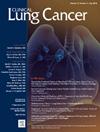Enhanced Recovery With Aggressive Ambulation Decreases Length of Stay in Lung Cancer Surgery
IF 3.3
3区 医学
Q2 ONCOLOGY
引用次数: 0
Abstract
Objective
Thoracic Enhanced Recovery with Ambulation after Surgery (T-ERAS) protocol at our institution includes ambulation into the operating room and 250-feet ambulation within 1 hour of extubation. We compared the average length of stay (LOS) between T-ERAS patients and that predicted using a validated surgical risk calculator.
Methods
We retrospectively reviewed patients undergoing lung cancer resection with minimally invasive approach from 2012 to 2022. Patients aged ≥ 18 were included if early ambulation was documented. Patient information were entered into the American College of Surgeon's National Surgical Quality Improvement Program Risk Calculator (NSQIP) to obtain the predicted LOS. Descriptive statistics, comparisons of observed versus predicted LOS (O/P ratio), and nonparametric testing were conducted.
Results
Of 940 patients reviewed, 886 met eligibility. For the study cohort, average age was 68, and 514 (58.0%) were female. By procedure, there were 631(71.2%) lobectomy, 204 (23.0%) wedge, 26 (2.9%) segmentectomy, 20 (2.3%) bilobectomy, and 5 (0.6%) pneumonectomy. The average LOS observed for the entire cohort was 1.2 days (median 1.0 day) compared to the predicted LOS of 3.4 days with the NSQIP (median 4.0). Overall, 842 (95%) of patients had LOS better than predicted (O/P ratio < 1), 19 (2.1%) had LOS as predicted (O/P ratio = 1), and 25 (2.8%) had LOS longer than predicted (O/P ratio > 1). The mean O/P ratio was 0.34.
Conclusion
Average LOS with T-ERAS protocol was 1.2 days compared to the predicted average of 3.6 days in patients undergoing minimally invasive lung cancer resections. Our study provides a potential protocol to shorten the LOS beyond what is predicted by NSQIP.
积极活动增强恢复可减少肺癌手术的住院时间。
目的:我院的手术后步行胸部增强恢复(T-ERAS)方案包括进入手术室的步行和拔管后1小时内250英尺的步行。我们比较了T-ERAS患者的平均住院时间(LOS)和使用有效的手术风险计算器预测的平均住院时间(LOS)。方法:回顾性分析2012年至2022年接受微创入路肺癌切除术的患者。年龄≥18岁的患者包括早期活动记录。将患者信息输入美国外科医师学会的国家手术质量改进计划风险计算器(NSQIP)以获得预测的LOS。描述性统计,比较观察到的与预测的LOS (O/P比率),以及非参数检验。结果:940例患者中,886例符合条件。在研究队列中,平均年龄为68岁,514名(58.0%)为女性。按手术方式,肺叶切除术631例(71.2%),楔形切除术204例(23.0%),节段切除术26例(2.9%),胆叶切除术20例(2.3%),全肺切除术5例(0.6%)。整个队列观察到的平均生存期为1.2天(中位1.0天),而NSQIP预测的生存期为3.4天(中位4.0)。总体而言,842例(95%)患者的LOS好于预测(O/P < 1), 19例(2.1%)患者的LOS符合预测(O/P = 1), 25例(2.8%)患者的LOS长于预测(O/P = 1),平均O/P为0.34。结论:在微创肺癌切除术患者中,T-ERAS方案的平均LOS为1.2天,而预测的平均LOS为3.6天。我们的研究提供了一个潜在的方案来缩短LOS,超出NSQIP的预测。
本文章由计算机程序翻译,如有差异,请以英文原文为准。
求助全文
约1分钟内获得全文
求助全文
来源期刊

Clinical lung cancer
医学-肿瘤学
CiteScore
7.00
自引率
2.80%
发文量
159
审稿时长
24 days
期刊介绍:
Clinical Lung Cancer is a peer-reviewed bimonthly journal that publishes original articles describing various aspects of clinical and translational research of lung cancer. Clinical Lung Cancer is devoted to articles on detection, diagnosis, prevention, and treatment of lung cancer. The main emphasis is on recent scientific developments in all areas related to lung cancer. Specific areas of interest include clinical research and mechanistic approaches; drug sensitivity and resistance; gene and antisense therapy; pathology, markers, and prognostic indicators; chemoprevention strategies; multimodality therapy; and integration of various approaches.
 求助内容:
求助内容: 应助结果提醒方式:
应助结果提醒方式:


